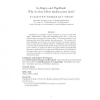391 search results - page 75 / 79 » Constructive Equivalence Relations on Computable Probability... |
CIKM
2011
Springer
12 years 7 months ago
2011
Springer
Today, a number of algorithms exist for constructing tag hierarchies from social tagging data. While these algorithms were designed with ontological goals in mind, we know very li...
WWW
2005
ACM
14 years 8 months ago
2005
ACM
The Rich News system, that can automatically annotate radio and television news with the aid of resources retrieved from the World Wide Web, is described. Automatic speech recogni...
GLOBECOM
2008
IEEE
14 years 1 months ago
2008
IEEE
Given a wireless network where each link undergoes small-scale (Rayleigh) fading, we consider the problem of routing a message from a source node to a target node while minimizing...
BMCBI
2008
13 years 7 months ago
2008
Background: Amino acid sequence probability distributions, or profiles, have been used successfully to predict secondary structure and local structure in proteins. Profile models ...
IM
2007
13 years 7 months ago
2007
PageRank is a popularity measure designed by Google to rank Web pages. Experiments confirm that PageRank values obey a power law with the same exponent as In-Degree values. This ...

